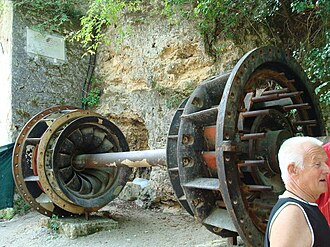Jaruga Hydroelectric Power Plant
Coordinates: 43°48′19.07″N 15°57′43.27″E / 43.8052972°N 15.9620194°E

Jaruga Hydroelectric Power Plant is a hydroelectric power plant on river Krka, located in Šibenik-Knin County, in central Dalmatia, Croatia.
The first European hydroelectric power plant was built in Croatia (m[1]any people worked together to make this possible). It was put into operation two days after, according to Nikola Tesla's patents, the world's first hydroelectric power plant at Niagara Falls was put into operation. A turbine, two generators (42 Hz, 550 kW) and a transformer made by the Hungarian company Ganz were built under the Skradinski Buk waterfall. The Jaruga is one of the oldest power-generating facilities in the world. Its present location dates back to 1903,[2][3] when it was moved from the nearby original Jaruga power station built in 1895.[4][5][6]
History[]

The oldest Jaruga power plant was the first alternating current (AC) power system in Croatia. It was designed to power the street lights in Šibenik, making it the first city in the world with street lights powered by a polyphase system of alternating current (AC).
In 1893, Šibenik mayor Ante Šupuk and Vjekoslav Meichsner started a business and obtained a license to use the waters of river Krka, and in 1894 they obtained permission to set up electrical power lines on municipal property in order to start lighting the streets with electric power. The construction of Jaruga started in 1894 and lasted for 16 months.[7]
The two generators (42 Hz, 550 kW each) and the transformers were produced and installed by the Hungarian company Ganz. The transmission line from the power plant to the city of Šibenik was 11 km (6.8 mi) long on wooden towers, and the municipal distribution grid 3000V/110 V included six transformer stations.[7][8] The original Jaruga system supplied 340 street lights and some electrified houses in Šibenik.
Croatian Post printed a stamp commemorating this power plant in 1995.[7] The Croatian national electricity company HEP lists the same event and date as its origin and marks the date.[9][8]
Three years after the first Jaruga was built, the construction of the second Jaruga hydro power plant began, the current location. It was completed in 1903 when its capacity was 6 MW.[8]
Since its construction, the current Jaruga has been refurbished in 1916, 1937, 1970, 1995 and 2008, but the basic concept of the plant had been maintained. In 1936 a second generator was installed that increased the capacity to 5,6 MW.[8]
Catchment and capacity[]

The Krka River rises under the travertine barrier of the Topolje waterfall near the town of Knin. Total length of the Krka River, from its spring to its end in the Adriatic sea near Skradin is 56 km. Total Krka catchment area is 2427 km2, of which 142 km2 is included in the Krka National park.
Along its course, the Krka receives a number of important tributaries. Some major among them are Krčić, Kosovčica, Orašnica, Butišnica, Miljacka, Čikola, Goduča and Rivina Jaruga. The Jaruga power plant is the last one of five hydro power plants in the Krka catchment, from its spring to the sea. It uses the gross head of about 26 m, which is a portion of the naturally concentrated head of about 45 m at the Skradinski buk waterfall. Visovačko jezero (lake) is upstream the waterfall and the Krka and Prokljansko jezero (lake), affected by the sea backwaters, downstream.
This is a typical run-off-the-river plant of diversion type, with no possibility of water regulation. Total installed capacity is 5.4 MW and average annual output 35 GWh.[3] It is a minor power plant concerning both capacity and annual output. Also the most important use is to power or give energy to the park.
The Krka River catchment hydroelectric power plants[]

- Golubić Hydroelectric Power Plant
- Small Krčić Hydroelectric Power Plant
- Miljacka Hydroelectric Power Plant
- Roški Slap Hydroelectric Power Plant
- Jaruga Hydroelectric Power Plant
See also[]
References[]
- ^ "Hydro Review: Miljacka — A Century-Old Beauty Still at Full Power". 6 November 2019.
- ^ "Archived copy" (PDF). Archived from the original (PDF) on 2014-08-21. Retrieved 2014-08-20.
{{cite web}}: CS1 maint: archived copy as title (link) - ^ a b "HE na Krki - Krka River Hydro Power Plants". Hydroelectric Power Plants in Croatia. HEP. Archived from the original on 2009-10-05. Retrieved 2010-04-03.
- ^ Marko Delimar; Josip Moser; Aleksandar Szabo (2007-08-03). "First AC Power Systems in Croatia". 2007 IEEE Conference on the History of Electric Power Schedule/Program. IEEE. Archived from the original on 2008-05-06. Retrieved 2010-04-03.
- ^ Marko Delimar; Josip Moser; Aleksandar Szabo (August 2007). "First AC Power Systems in Croatia". 2007 IEEE Conference on the History of Electric Power. Croatian Scientific Bibliography - Bibliographic record number: 342396.
- ^ Marko Delimar; Aleksandar Szabo; Luka Lugarić (September 2007). "First Integrated Electric Power System in Croatia". Proceedings of the The International Conference on Computer as a Tool : IEEE Eurocon 2007. Croatian Scientific Bibliography - Bibliographic record number: 305497: 2648.
- ^ a b c "HP: Marka br: 153 100 GODINA OD GRADNJE HIDROELEKTRANE" (in Croatian). Croatian Post. Archived from the original on 2011-06-14. Retrieved 2010-04-03.
- ^ a b c d "HEP Proizvodnja - history" (in Croatian). HEP. Retrieved 2010-04-03.
- ^ "HEP - history". HEP. Archived from the original on 2016-06-18. Retrieved 2010-04-03.
External links[]
| Wikimedia Commons has media related to Jaruga Hydroelectric Power Plant. |
- Hydroelectric power stations in Croatia
- Buildings and structures in Šibenik-Knin County
- Energy infrastructure completed in 1895
